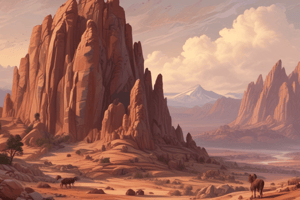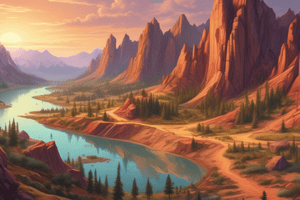Podcast
Questions and Answers
What is the primary reason for the formation of canyon landscapes?
What is the primary reason for the formation of canyon landscapes?
- Volcanic activity resulting in lava floods
- Erosion of horizontal layers at different rates (correct)
- Weathering of rocks due to temperature fluctuations
- Tectonic plate movement causing the land to uplift
What is the purpose of damming canyons?
What is the purpose of damming canyons?
- To generate hydro-electric power (correct)
- To study geological formations
- To support agricultural activities
- To create scenic tourist attractions
What type of rock protects the plateau in Karoo landscapes?
What type of rock protects the plateau in Karoo landscapes?
- Basalt
- Dolerite (correct)
- Granite
- Sandstone
What is the characteristic feature of rugged cliffs in canyon landscapes?
What is the characteristic feature of rugged cliffs in canyon landscapes?
What is the name of the popular tourist destination in South Africa known for its canyon landscape?
What is the name of the popular tourist destination in South Africa known for its canyon landscape?
What is the term for the remaining flat area of land in Karoo landscapes?
What is the term for the remaining flat area of land in Karoo landscapes?
What is the primary factor that influences the landscape of hilly areas in humid regions?
What is the primary factor that influences the landscape of hilly areas in humid regions?
What is the process in which a thin, mobile sheet of water flows over the surface of a hill-slope?
What is the process in which a thin, mobile sheet of water flows over the surface of a hill-slope?
What is characterized by steep slopes, minimal vegetation, and is formed by extreme erosion of softer sedimentary rocks and clay-rich soils?
What is characterized by steep slopes, minimal vegetation, and is formed by extreme erosion of softer sedimentary rocks and clay-rich soils?
How are horizontally layered rocks formed?
How are horizontally layered rocks formed?
What is the characteristic of hilly landscapes in dry/arid areas?
What is the characteristic of hilly landscapes in dry/arid areas?
What is built up over millions of years by lava pouring out of long narrow cracks in the ground?
What is built up over millions of years by lava pouring out of long narrow cracks in the ground?
Flashcards are hidden until you start studying
Study Notes
Horizontally Layered Rocks
- Form where layers of rocks are flat lying, resulting from sediments deposited by wind and water
- Sediments are turned into rocks over millions of years as more layers are deposited
- Formed when:
- Horizontal sedimentary rocks are uplifted without changing position
- Lava flows on the surface cool, forming layers of igneous rocks
- A sill (igneous intrusion) is exposed to the surface
Hilly Landscapes
- Influenced by climate and rock resistance
- In humid areas:
- Large amount of rainfall leads to erosion through sheet wash
- Smooth and rounded hills form
- In dry/arid areas:
- Less rainfall leads to less water erosion
- Rugged hilly landscapes with steep slopes and little rounding form
- Can also be referred to as Badlands, characterized by steep slopes and minimal vegetation
Basaltic Plateau
- Formed by lava pouring out of long narrow cracks in the ground
- Built up over millions of years, forming deposits hundreds to thousands of meters thick
- Example: The Drakensberg, a popular tourist destination
Canyon Landscapes
- Develop where horizontal layers erode at different rates
- Running water finds weak places in the hard surface layer, eroding vertically into the land
- Form deep valleys with stepped sides and resistant rock forming steep cliffs
- Less resistant rocks form gentler slopes
- Example: The Grand Canyon in the USA
Uses of Canyons
- Can be dammed to make very deep dams, often used for hydro-electric power
- Surrounding plateau may be too dry for agricultural value
- Impressively scenic, making them popular tourist attractions
Karoo Landscapes
- Develop from canyon landscapes
- Plateau remains the same height due to cap rock
- Large areas are covered with horizontal layers
- Rivers erode vertically, forming canyons with landforms like Mesas, Buttes, and Conical Hills
- Example: The Blyde (Motlase) canyon in Mpumalanga
Studying That Suits You
Use AI to generate personalized quizzes and flashcards to suit your learning preferences.




